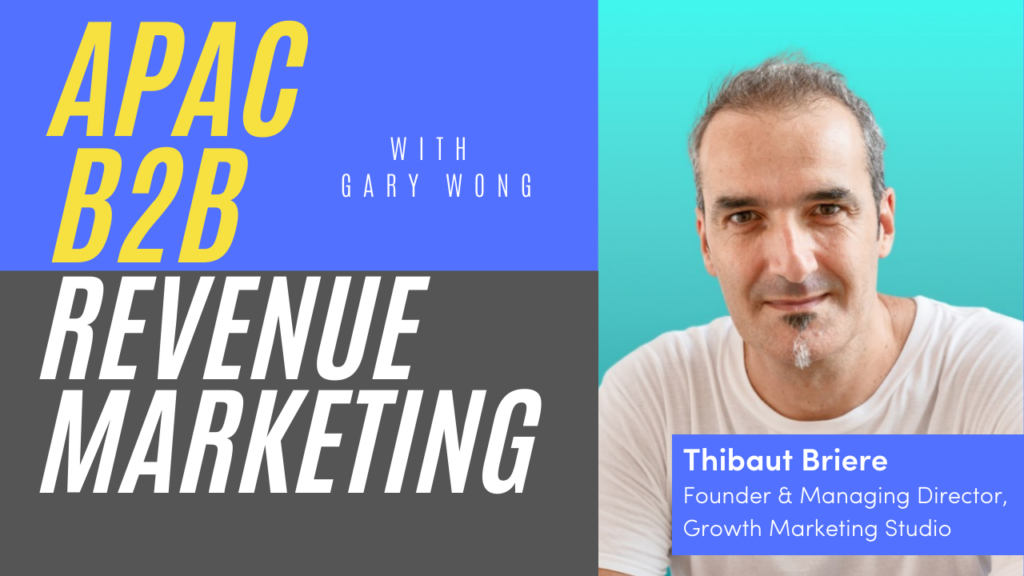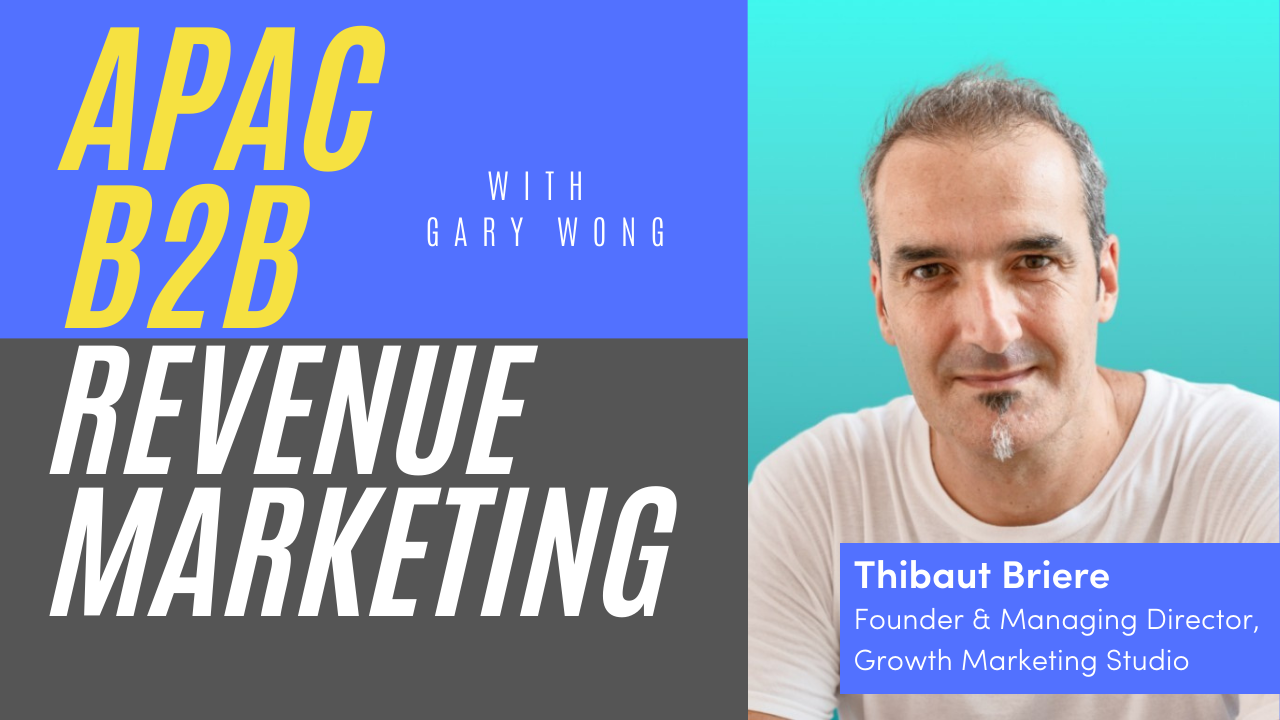In Conversation with Thibaut Briere, Founder and Managing Director at Growth Marketing Studio
Listen to the full podcast: https://www.buzzsprout.com/1824245/9127606
Doing marketing at a startup is difficult. You have limited resources, you are still trying to find product market fit and there are just so many areas that can go wrong.
And lucky enough, we have got Thibaut Briere, Founder and Managing Director at Growth Marketing Studio to share with us the steps and roadmap that startups should follow to have a higher chance of success.
Thibaut is a developer who’s been in marketing for 15 years. He has worked in unknown 3-people startups as well as big corporates like Nokia and Cisco. And this time, he will uncover some of the common and totally avoidable mistakes that startups are making when it comes to marketing.
Time to see what I have learnt!
In your career, how did you go from being a developer to a B2B marketer?
I don’t have a typical marketing background. I started off being a developer for like 6 years working at a startup which was acquired by a corporate. So I got a new job in the corporate to create this innovation lab. It was like an open innovation hub for the corporate to work with startups and I did that for 2-3 years before I moved fully into marketing for 15 years now and counting.
The reason I wanted to change was because even when I was a developer, I realised that my strength was not so much to be in coding. I was not the best coder out there. But I could talk to people and identify gaps between the product and the actual problem that it is trying to solve.
As developers, we all like to sit behind screens and play with new tech but ignore the actual usage of the technology. And that’s why I switched to working in the innovation lab but then I realised, in order to put a product out to the market, you need marketing. And I had no idea how to do that.
So that’s why I decided to move into marketing so I can actually help bring these technologies to the market.
What’s your first impression of marketing?
To give you a bit of context, I was working at Nokia at the time. They still had a strong brand back then but at the same time, being a gigantic company, they are slowly losing their mission.
So when I first joined the marketing team, I was super excited but then fast forward 3 months, we would still be working on this slide deck from some mega trends report that we read and it was going to be the guide for the business in the coming year. I was super surprised that we didn’t meet any costumers and spent a quarter of the year just to work on this. It just didn’t make sense for me in my engineering brain.
Then, I decided to go and talk to the sales guys but I wasn’t welcome. Sales and marketing were in two completely different worlds and I had to prove myself to join some of their meetings with the customers. That’s when I realised that the customers already knew all these trends already, they wanted specifics. What it means for them as a business and how we could solve these problems for them as a company.
So I came out and my biggest lesson was that marketing to me was a supporting function to sales and we should try to be useful to them. And meeting and talking to as many customers in your first 30,60,90 days would be an eye-opening and crucial moment for us to think about our next move.
What are some of the biggest differences between doing marketing at a startup vs corporate?
I mean when you are doing marketing at a startup, you are like naked in a war field. You don’t have the money, the tools or a big team. So you need to be super focused on what matters the most and how to achieve the best results with limited investments.
Whereas in large companies, you usually have a lot of resources so it doesn’t really create a constraint situation that pushes you to innovate. You won’t feel the pressure or as much heat every morning to go to work and get something done or out the door quickly.
A funny story that I wanted to share is when I first joined Cisco to help build their digital marketing capabilities, they had 168 tools in their marketing stack. I was shocked and was thinking how was I going to each each of these tools? So basically everyday in the morning, we open that dashboard, Salesforce and different kinds of things and at one point, we had to just forget all these tools and try to come back to what we needed to focus on.
So basically we go to work every day in the morning, we open up the dashboards, the, you know, the Salesforce and you know, all these things.
So that was the typical situation you can find in large companies and that would be probably the biggest difference.
So what is the first step startups should do when it’s time for them to start doing more marketing?
So usually the way it works is that you have a bunch of founders and they have this idea of a product. You start building it and then you will better understand what exactly you need and how difficult it would be to build this product.
Then this is the time where you shift your focus and start talking to people about how your idea can help them solve a specific problem. You don’t want to pitch the product but instead, have a conversation with your audience about the problem they have and your potential idea of the solution.
You want to build kind of a system in place to find the people who have the problem and talk to them on a regular basis. They can be on Facebook groups, forums, cafes, co-working spaces but you need to go and find these people. It is very manual but there is no shortcut. You have to do that.
So what happens after is that you understand how they think about the problem and use their words to talk about the problem which you can use in marketing. Also you can understand their emotions about the problem. Are they bored, tired and stressed?
Can you share an example?
Previously I was on webinars with the CEO of Carousell when they launched their app. They quickly became the number one app in the shopping category. And nothing much happens after.
So they were super happy to be first in their category but that only lasted a few days and they only got a few signups after. It wasn’t working out and what they did was go back and talk to the users.
They went into shopping malls and tried to have as many listings as possible. Printing posters, sitting in the malls and talking to people about their app. And by doing that, they identify a very specific demographic to be focused on which is 15-24 years and they are interested in fashion. They started very niche.
They sort of relaunched their product just in that niche because they were getting the most interest and traction from this group of audience. That’s where the growth came and in 18 months, they became the number one app for shopping category again.
I guess it’s a good illustration of why startups should be talking to people.

What are some of the common mistakes startups are making when it comes to marketing?
There are quite a few of them.
The first mistake I see is that they start marketing too late and wait to have the product ready. Whereas we know there’s no such thing as a product ready, right? Carousell is 9 years old and still building their product. So start marketing early on.
Again not talking to people is another one. I guess the mistake is that they have a website or an app, they are going to run ads and wait for something to happen. Facebook and Google have made their platforms so easy to use that startups will just go run some ads and try to make sense of the data without really figuring out who they should be targeting or talking to the customers first.
Another one is too driven by tools and digital data. They are on LinkedIn or Facebook and hear about these tools and start using them for no reason. Then you end up with a lot of different tools that are scattered all over the place. And for data, yes it will be great to capture all the data and trying to understand everything will require expensive tools. And expensive experts to manage them.
So I always suggest don’t try to measure everything because it takes a lot of time to have accurate data. And you need to be able to move and have the capacity to make decisions without having too much data. And sometimes data can be misleading.
I’m going to try and capture. You’re magic and you have a millage and turn that into, um, like what is the state’s process? How can we automate as much as we can the sales process and how can we infuse that in our marketing, you know, outreach activities, uh, you know, our, you know, emails, frequencies, et cetera, rights.
What are some of the major changes that you are seeing or you think we will see in B2B marketing?
I think we are moving back towards more brand and inbound marketing versus performance marketing for a number of reasons such as privacy issues and a cookieless world.
Another key trend that I see is that more B2B brands are trying to build a community and it kind of has that word of mouth impact for the brand which is interesting. I guess this can be caused by COVID-19 as we all have been living online for a year and a half now and eventually we are still human, and we need that connection and talk to people. So that’s why brands are creating a community on top of the product for the users to discover other like-minded individuals with the same issues and problems.
Also I am seeing this emergence of micro-enterprises. We are in this passionate economy or creative economy that few persons can already create their own company. So the way you market or sell to them is actually more B2C like than B2B. And I think this segment is going to grow larger and larger.
Last trend is that a lot of micro products are coming up which can be very useful for individuals but at the same time, they can be applicable for SMBs or even bigger companies. So this B2C2B model arises that you are marketing and targeting individuals first and aim to extend to the companies that these individuals are working in.
******************
Connect with Thibaut Briere on LinkedIn: https://www.linkedin.com/in/thibautbriere/
Listen to the full podcast: https://www.buzzsprout.com/1824245/9127606
theinacademy.com
Take a look around.
[in]side the algorithm
Inside the Algorithm is your weekly download of all things business and magnetic content marketing, from exclusive LinkedIn insider Tips by Salina & Faisal to incredible guest contributors.
JUICY DEETS EVERY WEDNESDAY MORNING!
